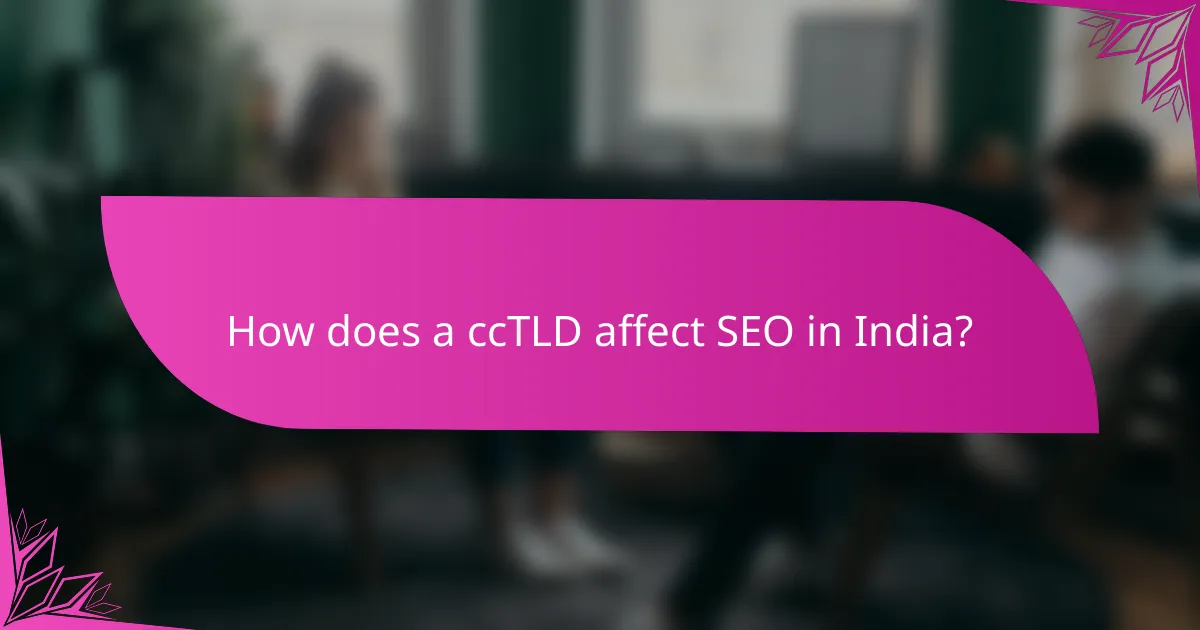Choosing the right country code top-level domain (ccTLD) is crucial for Indian businesses looking to establish a strong local presence. The .in domain is often the best choice, as it builds trust with Indian consumers and can improve local search visibility. Additionally, businesses should evaluate their target audience and overall brand strategy to ensure their ccTLD aligns with their goals.

Which ccTLD is best for Indian businesses?
The best ccTLD for Indian businesses is typically .in, as it signifies a local presence and can enhance trust among Indian consumers. However, businesses should also consider their target audience and brand strategy when choosing a ccTLD.
.in ccTLD advantages
The .in ccTLD offers several advantages for Indian businesses, including improved local search engine rankings and enhanced credibility with local customers. Using a .in domain can signal to users that the business is specifically catering to the Indian market.
Additionally, having a .in domain can help businesses establish a stronger connection with their audience, as it reflects a commitment to the local community. This can be particularly beneficial for small to medium-sized enterprises looking to build brand loyalty.
Comparative analysis of .co.in
The .co.in ccTLD is another option for Indian businesses, often used by companies that want to emphasize their commercial nature. While .in is more straightforward, .co.in can be a suitable alternative for businesses that may find their desired .in domain unavailable.
However, .co.in may not carry the same level of recognition as .in among consumers. It’s essential to weigh the potential benefits of brand identity against the possible confusion it might create for customers who are more familiar with .in domains.
Benefits of using .com
The .com domain is globally recognized and can provide a broader reach beyond the Indian market. For businesses planning to expand internationally, a .com domain can enhance brand visibility and credibility on a global scale.
However, using a .com domain may not convey a local presence as effectively as a .in domain. Businesses should consider their target market and whether they prioritize local engagement or global outreach when selecting a domain.
Impact of local ccTLDs
Local ccTLDs, such as .in, can significantly impact a business’s online presence by improving local SEO and fostering trust among customers. Search engines often prioritize local domains in search results, making it easier for potential customers to find relevant services.
Moreover, local ccTLDs can enhance brand loyalty as they resonate more with the local audience. Businesses should assess their target demographic and consider how a local ccTLD can align with their marketing strategy to maximize engagement and conversion rates.

How does a ccTLD affect SEO in India?
A country code top-level domain (ccTLD) can significantly influence SEO for businesses operating in India. Using a .in domain can enhance local search visibility and connect better with Indian consumers, as search engines often prioritize local domains for regional queries.
Local search ranking benefits
Utilizing a ccTLD like .in can improve your website’s ranking in local search results. Search engines tend to favor local domains when users search for services or products specific to India, which can lead to higher visibility in search engine results pages (SERPs).
For example, a business with a .in domain may rank better for searches like “best restaurants in Delhi” compared to a .com domain. This localized approach can attract more relevant traffic, ultimately increasing conversion rates.
Trust and credibility factors
Having a ccTLD can enhance your business’s trustworthiness among Indian consumers. A .in domain signals that your business is local, which can foster a sense of reliability and connection with potential customers.
Moreover, many users prefer to engage with websites that have a local domain, as they often associate them with better customer service and understanding of local needs. This perception can be crucial in building long-term customer relationships and loyalty.

What are the costs associated with ccTLD registration?
The costs associated with ccTLD registration for Indian businesses can vary based on the registrar and specific services offered. Generally, you should consider both the initial registration fees and the ongoing annual renewal costs to maintain your domain.
Registration fees for .in
The registration fees for a .in domain typically range from INR 500 to INR 2,000 for the first year, depending on the registrar you choose. Some registrars may offer promotional rates or bundled services that could affect the overall cost.
When selecting a registrar, compare their offerings, including customer support and additional features like privacy protection or web hosting. Ensure you understand what is included in the registration fee to avoid unexpected expenses.
Annual renewal costs
Annual renewal costs for a .in domain usually range from INR 500 to INR 1,500. It’s essential to check the renewal rates of your chosen registrar as they can differ significantly from initial registration fees.
Be mindful of renewal deadlines to prevent losing your domain. Some registrars offer auto-renewal options, which can help ensure your domain remains active without interruption. Always review the terms of service regarding renewal to avoid surprises.

What are the legal requirements for ccTLDs in India?
In India, the legal requirements for country code top-level domains (ccTLDs) primarily involve compliance with local regulations and proper documentation during registration. Businesses must ensure they adhere to the guidelines set by the Internet Corporation for Assigned Names and Numbers (ICANN) and the National Internet Exchange of India (NIXI).
Compliance with Indian regulations
To register a ccTLD in India, businesses must comply with specific regulations that govern domain names. This includes ensuring that the domain name does not infringe on existing trademarks and adheres to the rules set by NIXI, which oversees the .in domain namespace.
Additionally, businesses should be aware of the legal implications of using a ccTLD, such as the requirement to maintain accurate registration information and the potential for disputes if the domain is misused. Regular updates to registration details are crucial to avoid penalties.
Documentation needed for registration
When registering a ccTLD in India, applicants must provide certain documentation to verify their identity and business legitimacy. This typically includes a government-issued ID, proof of address, and business registration documents.
For Indian businesses, a Certificate of Incorporation or a partnership deed may be required, along with a No Objection Certificate (NOC) if the domain name includes a trademarked term. Ensuring that all documentation is accurate and complete can streamline the registration process and prevent delays.

How to choose the right ccTLD for your target audience?
Selecting the appropriate country code top-level domain (ccTLD) for your Indian business involves understanding your audience’s preferences and behaviors. A ccTLD can enhance local trust and relevance, making it crucial to align your choice with your target market’s characteristics.
Understanding audience demographics
Demographics play a vital role in ccTLD selection. Consider factors such as age, location, language, and purchasing behavior of your target audience. For instance, if your business primarily serves urban millennials in India, a .in domain may resonate more than a generic .com.
Additionally, cultural nuances can influence domain perception. A ccTLD can signify local commitment, which may appeal to customers seeking businesses that understand their specific needs and values.
Market research tools for ccTLD selection
Utilize market research tools to gather insights on your audience’s online behavior and preferences. Tools like Google Trends, SEMrush, and Ahrefs can help you analyze keyword searches and domain popularity in your target region.
Surveys and focus groups can also provide direct feedback from potential customers about their domain preferences. This qualitative data can guide your decision, ensuring that your ccTLD aligns with your audience’s expectations and enhances your brand’s local presence.

What are the alternatives to ccTLDs for Indian businesses?
Indian businesses can consider using generic top-level domains (gTLDs) or subdomains as alternatives to country code top-level domains (ccTLDs). These options can provide flexibility and broader reach while still catering to local audiences.
Using gTLDs effectively
gTLDs, such as .com, .net, or industry-specific options like .tech or .store, can be effective for Indian businesses looking to establish a global presence. They are widely recognized and can enhance credibility, especially for companies targeting international markets.
When using gTLDs, it’s crucial to choose a domain that aligns with your brand and is easy to remember. Avoid overly complex names or obscure extensions that may confuse potential customers. For example, a tech startup might benefit from a .tech domain, while an e-commerce site could opt for .store.
Benefits of subdomains
Subdomains allow businesses to create distinct sections of their website under the main domain, which can be useful for targeting specific audiences or services. For instance, an Indian business could use a subdomain like shop.example.com for its online store while maintaining a blog at blog.example.com.
Using subdomains can enhance SEO by allowing for targeted content and keywords relevant to different segments of your audience. However, ensure that each subdomain is well-maintained and provides valuable content to avoid diluting your brand’s overall message.

How can you leverage ccTLDs for brand expansion?
Leveraging country code top-level domains (ccTLDs) can significantly enhance your brand’s visibility and credibility in specific markets. By using a ccTLD, such as .in for India, you signal to customers that your business is local and tailored to their needs, which can foster trust and improve engagement.
Strategies for regional targeting
To effectively target regional audiences, consider using ccTLDs that resonate with local customers. This includes optimizing your website content in local languages and incorporating culturally relevant imagery and messaging. For instance, a business targeting Indian consumers might use .in and provide content in Hindi and English.
Additionally, ensure that your website complies with local regulations and standards, such as data protection laws. This can enhance your reputation and reduce legal risks. Regularly update your content to reflect local trends and preferences, which can help maintain relevance in a competitive market.
Case studies of successful ccTLD use
Several businesses have successfully utilized ccTLDs to expand their brand presence. For example, a popular Indian e-commerce platform, Flipkart, uses .in to establish its identity as a homegrown brand, which has contributed to its strong market position against international competitors.
Another example is the travel agency MakeMyTrip, which employs .in to cater specifically to Indian travelers. By focusing on local needs and preferences, they have successfully captured a significant share of the domestic travel market. These case studies illustrate how strategic use of ccTLDs can lead to enhanced brand loyalty and customer engagement.
